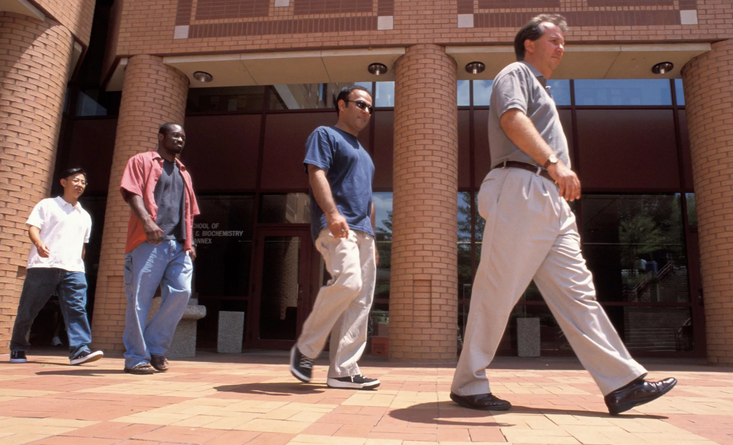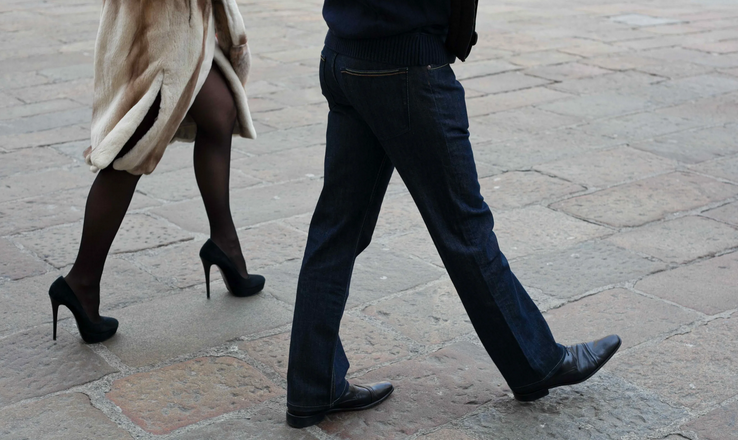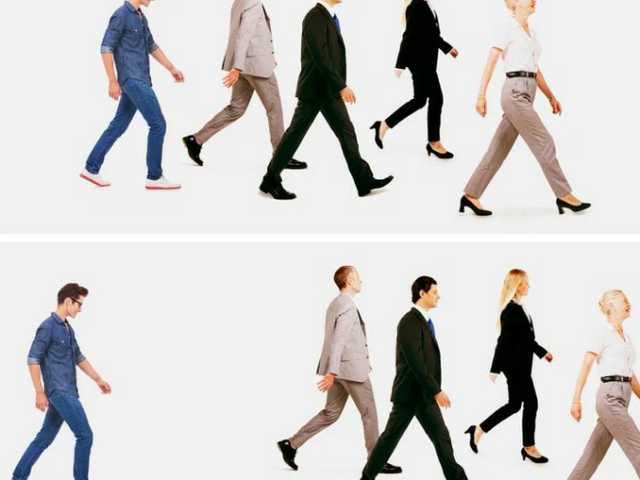By gait, simply determine the nature of a man or woman. The main thing is to take into account the characteristics of a person.
Content
- Types of human temperament and their features
- Gait: What is, what does it change from?
- How to determine the character of a person by gait?
- What is the gait: influence on the character
- Video: What is the gait of a person about?
- Video: How to find out about a person by gait?
- Video: What does the gait say about you?
People walk along the street, and each counter differs from another gait. So fast and energetic, waving his hands, a young man goes. Tsukah heels, a girl hurry to a stop. A shuffling gait, leaning on a stick, went and sat on a bench on the bench. With a tired gait, hunched over, a man goes. It is likely that he is after a heavy shift. But the young woman in an elegant dress goes slowly, relaxed gait. And she is happy, seeing her admiring glances. They are all different, each with their own characteristics.
Read on our website another article on the topic of physiognomics - definition of the character of a man and a woman in the shape of a head.
From this article you will learn how to determine the character of a person by gait. In fact, it is easy to watch people is very interesting. Read further.
Types of human temperament and their features

Temperament is certain features of the emotional and dynamic aspects, characteristic of individual man. He is responsible for the formation of positive and negative personality traits. It can be called an innate feature of the individual. Not subject to changes. This quality helps easier or harder to cope with the set life situations and respond to them.
If we consider temperament from the point of view of physiology, then it is due to the highest nervous activity of a person. It depends on it:
- The pace or rhythm of human activity throughout life and even gait
- The frequency and intensity of the manifestation of emotions
- Ability to control and evaluate oneself
- The speed of the psychological process, the ability to think quickly, perceive what has been said, the ability to concentrate and duration of concentration
Psychology divided all people into four groups like temperament. Here are their types and features:
- Choleric. Emotional personality. He has “living” speech, often with gestures. With enthusiasm, he is taken for any business, constantly striving for a new one. Quickly on decision -making and resourceful in the dispute. It shows its feelings very vividly. People of this type are uninhabited and unbearable, but in a conflict situation they can give a worthy rebuff. A passionate nature can provoke an incident itself. Smallness and vivid emotionality can be mistaken for aggression. During the depletion of the energy reserve, the mood of the mood occurs, a nervous breakdown is possible.
- Sanguine. Restrained and balanced nature. She tends to adapt to various life situations. In stress, he retains self -control, with conflicts, he argues himself. A good organizer who can show persistence to achieve the goal. It shows enthusiasm in the work begun, but if interest is lost, it does not bring it to the end, sunbathing with a new idea. Sanguine's performance is simply amazing.
- Phlegmatic person. A man of this type is restrained, calm, patient and rehabying. Very restrained to emotional outbursts and difficult situations in life. There is no bright color in his speech, it is calm and measured, there are no gestures. And in general, phlegmatic people are of little talkative. They are not confused by the monotony and monotony of work. They deeply hide their true feelings. Reason prevails over them. It is distinguished by good memory, order and accuracy in everything. They converge very hard with new people. The stinginess of emotions and their thoroughness are mistakenly perceived as indifference and boring. Phlegmaticians are reliable and devoted. It is worth remembering this.
- Melancholic. Personality with increased sensitivity. Demanding on themselves and others, tactful and restrained in communication. They feel comfortable only in a familiar and familiar environment. This type of character is characterized by resentment, strong impressionability. Emotionality can manifest itself even with tears. Their feelings are deep, they are given to them without a trace.
Temperament will tell the features inherent in the character of a person if you can quickly determine it. Accordingly, temperament also affects the gait. All because it changes depending on its appearance. Let's understand in more detail. Read further.
Gait: What is, what does it change from?
A gait is a feature of walking, an individual feature of each person. It includes the length of the step, the rhythm of movement, the position of the body, the movement of the hands. Its change can be a consequence of age, pathologies (congenital and acquired), changes in character traits.
From the side of medicine, the gait will tell what a person is sick with. For certain diseases, there is only characteristic of them. For example: Paretic - “a consequence of the paresis of the muscles of the lower extremities”, the rooster - “a high lifting of the leg in the knee at a step so that the hanging toe does not cling the road” with multiple sclerosis. The shuffling develops against the background of neurological diseases and general weakness, characteristic of people of very elderly. “Duchenna's lameness” often happens after a mechanical trauma to the removal group of the hip muscles. Polar - a consequence of alcohol or drug intoxication, when a sense of obedience of the legs when walking disappears.
How to determine the character of a person by gait?

Of course, a gait can tell a lot about a person. One has only to take a closer look, and knowing some nuances of decryption, you can, not getting to know a person closely, find out it very well. How to determine the character of a person by gait? Here are a few main nuances:
- Posture
How often in childhood we hear the phrases: “Do not stoop, straighten your back”, “your spine will bend.” The hunched back and the reduced shoulders do not decorate, and are harmful to health. A tightened and stiff person when walking is an indicator of an uncertain person who tries not to get into the field of attention of others. The gaze lowered at the same time or a reset to the side speaks of awkwardness, uncertainty, a possible feeling of guilt and shame. And on the contrary, the expanded shoulders, a straight back give out a self -confident person.
- Speed \u200b\u200bof movement
A quick and wide step is characteristic of gusty and energetic natures. A swift step is the gait of a leader leading people endowed with a strong will. This is depicted in the films of the gusty and rapid Peter the first, first Russian emperor. A wide and slow step of a self -confident person. So the leaders of the countries, very wealthy or burdened by power, go. A slow and inconsistent step in a person who knows his price, who has reached certain guidelines. But people of short stature can have such a step. Often such a gait is characteristic of women. A fussy person moves at a constantly changing pace.
- Step and its length
It is believed that short steps are taking an insecure person, and the shorter they are, the more this feeling owns them. A widely walking person seems to claim that he is impeccable and absolutely confident in himself. He is not just a leader, he is almost a dictator. This can be said about a person with a sedate tie, giving the significance and affirming himself. Men often go measured, relatively wide step, about 79 cm. The average length for humans is 71 cm, an ancient measure of length. Women have a shortest step - about 66 cm. If the lady goes in high -heeled shoes, the steps will be short for the convenience of walking.
- The position of the foot
The socks of the feet diluted as sides will indicate his confidence, curiosity, the desire not to miss anything. The socks turned inside determine the insecure, shy and not wanting to be in the forefront. A shuffling gait - the person has no desire, the desire to move along the career ladder. Movements resembling fear of losing shoes are characteristic of people who have lost life guidelines.
- A wave of hands
It is unlikely that in ordinary life you can meet a walking person who tightly pressed and extended his hands on the sides. This can be seen at the military parade of the walking system of military personnel. People are characterized by gestures even in the process of walking. This may be a way to involve a nearby satellite in a dialogue. The rhythmic movement of the hands with a springy gait is characteristic of athletes and confidently going to the goal. Such a person is full of optimism. Walking next to him, you can recharge with this energy.
The sluggish movement of the hands lowered along the body will indicate an amorphous personality or the softness of character. An attempt to press hands to the body is characteristic of insecure and timid natures. But the hands in your pocket may look like aggression or unwillingness to contact with the interlocutor. Perhaps the opponent experiences a feeling of distrust and is not ready to stretch out a hand to establish a relationship. This may be the lack of mood for frank conversations or immersion in your own problems.
- Tilt of the head
Low -lowered head when walking is a clear owner of various complexes. The combination of other external signs can indicate sadness, thoughtfulness and suffering, severe fatigue. A person constantly looking around, perhaps excited or scared. It can be a look for a look. A raised head and chin will indicate a strong -willed and confident personality. The upturned nose on a high head, otherwise they say the lifted up, will help to make out the shade and the proud.
What is the gait: influence on the character

There are several more gait features. They also affect the character of a person. It is important to notice all the details. For example:
- Fast in a hurry
A person is emotionally stable, confident, passionate and temperamental. It is filled with optimism and can “infect” others to them. A quick step can indicate an honest and open person.
- Slow gait
It goes as if walking. Pay attention to the alert of a person. He is in no hurry, but freezes his every step to avoid the dangers arising on the street. Seeing such a person, you can even rephrase the saying "you are slowly going - you are guaranteed to reach the goal."
- With a body tilt to the left
The right half of the brain, which is responsible for the left side of the body, helps to cope with uncertainty and fear. A person experiencing deep excitement or stress, when walking, tilts his body to the left. This is confirmed by psychologists' research.
- Direct posture and high head
That is how the model is going on by the catwalk or a well -known and popular person on the red carpet. Light and slow - will give out a confident person who is absolutely not doubtful of the correctness of his actions.
- Nervous and fussy
The impression of a constantly late, hurrying person is created. Endless waves of hands, sharp and chaotic movements. It is difficult for such people to relax. But they do not know how to do this, because they need to keep everything under control, keep up everywhere, control every detail.
- Graceful and graceful
More often it is characteristic of women, confident in themselves and their irresistibility. Catch on yourself admiring glances, moving, as if in a dance in the ballroom on the floor. It is such a gait in people who have been dancing professionally since childhood. Some attribute to it the defile, but it is difficult to call a beautiful gait literally twisting legs. In sane people, this causes a sense of fear for the safety of the life of the model.
Straighten your back, raise your head, change your gait if it does not suit you. Perhaps your character will change with it. You will become more self -confident and will boldly walk through life.
Video: What is the gait of a person about?
Video: How to find out about a person by gait?
Video: What does the gait say about you?
Read on the topic:
- Physiognomy: determination of the character by the neck
- Physiognomy - determination of the nature of the shape of the nose
- Physiognomy: determination of the nature of the shape of the forehead
- Physiognomy: determination of the character in the shape of the ears
- Physiognomy: determination of character by cheeks







